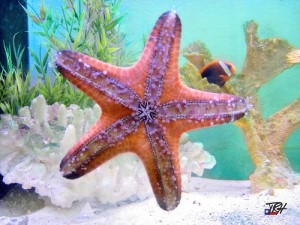In earlier posts I’ve linked to Climbing Mount Improbable, Richard Dawkins’s excellent explanation of the theory of evolution. One of my favorite chapters was Chapter 7, titled “Kaleidoscopic Embryos.” It surveys some of the striking regularities in the body plans of living organisms. For example, almost every animal possesses left-right symmetry. Many animals have other symmetries. Starfish, for example, are commonly 5-way radially symmetrical. Also extremely common is segmentation. The bodies of worms and centipedes essentially consist of repeated copies of the same basic segment pattern, with minor variations from one segment to the next. And indeed, more complex organisms frequently have echoes of this body pattern. Human spines, for example, consist of repeated instances of virtually identical vertebrae.
Dawkins calls these development plans “kaleidoscopic” because these organisms develop by repetition of simpler patterns, just as a kaleidoscope creates pretty pictures by using mirrors to repeat patterns of light. He argues that the emergence of kaleidoscopic development patterns is the result of a kind of “meta-evolution.” Segmentation and symmetry don’t directly improve the organism’s reproductive fitness, but it makes it “better at evolving.” Imagine, for example, if each of a starfish’s five arms evolved separately. If a mutation caused an improvement in one arm, the animal would only get one-fifth the benefit a symmetrical starfish would receive.
 There an important lesson here for the debate over the decline of the newspaper industry. Take, for example, Richard Posner’s widely criticized post calling for changes to copyright law to forestall the demise of the newspaper industry. In his model of the news business, there are some mainstream news companies who are in the business of producing “the news.” Then there are a bunch of other Internet firms that have a basically parasitic relationship with the mainstream media outlets. Posner writes that “it is much easier to create a web site and free ride on other sites than to create a print newspaper and free ride on other print newspapers”
There an important lesson here for the debate over the decline of the newspaper industry. Take, for example, Richard Posner’s widely criticized post calling for changes to copyright law to forestall the demise of the newspaper industry. In his model of the news business, there are some mainstream news companies who are in the business of producing “the news.” Then there are a bunch of other Internet firms that have a basically parasitic relationship with the mainstream media outlets. Posner writes that “it is much easier to create a web site and free ride on other sites than to create a print newspaper and free ride on other print newspapers”
Posner concludes that changing copyright law may be needed to “keep free riding on content financed by online newspapers from so impairing the incentive to create costly news-gathering operations” that the AP and Reuters become the only remaining producers of news.
Posner suffers from a lack of imagination, and in particular a failure to appreciate that the news industry is subject to its own kind of “meta-evolution.” On one level, Individual news outlets compete with each other for readers and advertisers. Some attract readers and prosper; others lose readers and go out of business.
If that were the whole story, Posner’s argument would be pretty compelling. Luckily, it’s not. At the same time individual news organizations are competing against one another, we’re also seeing a kind of memetic evolution. News organizations are constantly experimenting with new ways to do business, and successful experiments soon get copied by other news outlets.
One of the most important examples, which I alluded to in one of my first posts, is the emergence of the link economy. Web-native publications pay a great deal of attention to who they link to, and who links to them. Over time, complex norms have evolved governing when links are expected. When an online outlet is perceived (inaccurately, perhaps) as having violated those norms, they are subject to retribution in the form of other publications withholding links to them.
I know from personal experience that online news outlets take this kind of thing very seriously. For example, Ars vehemently insisted that this was a genuine coincidence (FWIW, I believed them). They understood that a reputation for failing to credit the sources of their stories would have a big negative effect on their traffic.
There are two things to note about this. First, the link economy helps to solve the problem that Posner is worried about: how to make sure that original news-gathering is properly rewarded. As the news business gets more decentralized, inbound links will become a more and more important source of traffic. A norm of linking to your sources ensures that sites that do real reporting will get more traffic. And a norm of never linking to sites that fail to observe the first norm ensures that it is widely followed.
Second, it’s not a coincidence that this link-oriented “social contract” has emerged in the blogosphere. Norms are subject to competitive pressures just as individual sites are. Over time, practices that make the blogosphere work better will grow with the sites that adopt them. This is a kind of “meta-evolution”: just as changes in the structure of animals’ body made beneficial mutations more likely, so the structure of the news business is changing in ways that enhances the incentives to produce original content.
Unfortunately, this is hard to explain to people with a newspaper-centric worldview. The modern newspaper industry has norms of its own that were forged in a very different technological environment. The “social contract” among newspapers is based on the assumption that all major newspapers will be large, hierarchical organizations like them, and that each will employ a large number of reporters producing original content. And so when they look at the decentralized structure of the online news business, it doesn’t look like an alternative way to organize the enterprise of gathering news. It just looks like they’re cheating.




